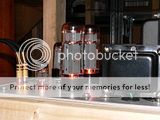Here's a question for those who have a Simple SE with an Allied 6K7VG, Hammond 274BX, 374BX, or other equivalent 750VCT power supply. What size cathode resistors would you use to run EL34 output tubes? I thought I spotted a couple of people running with 560 ohm parts, but George's table suggests that might run them at too high dissipation. It seems I ought to be using no less than 750 ohm.
Any comments?
Any comments?
I have 560 ohm resistors in my EL34 amp. The tubes are older JJ's and there is no glow in a dark room. It is about 2 years old now, but it does not get daily use. I have tried other EL34's and some show a very faint plate glow in a dark room wnen the line voltage is high (123 volts). You may use a 680 ohm for a more conservative bias current.
That's seems consistent what what I've read in other posts.
I recently purchased a set of Electro Harmonix EL34. I immediately noticed glowing spots on the screens within minutes of powering up the amplifier. I've upped the cathode resistors to 810 ohms and briefly tried them again. Idle current is 52 mA. Screens are still glowing. This isn't normal, is it? I never saw any glowing screen grids with my 6CA7EH, 6p3s-e, or KT88.

I recently purchased a set of Electro Harmonix EL34. I immediately noticed glowing spots on the screens within minutes of powering up the amplifier. I've upped the cathode resistors to 810 ohms and briefly tried them again. Idle current is 52 mA. Screens are still glowing. This isn't normal, is it? I never saw any glowing screen grids with my 6CA7EH, 6p3s-e, or KT88.

Simple SE and cooking my screens
Resurrecting an old thread... I'll try to keep it brief.
A while ago I tried a pair of Electroharmonix EL34 in my Simple SE. As noted above, I observed glowing grid wires, visible through the plate holes. I wrote off the experiment as a failure. Determined to find some EL34 that work, I bought a set of Sovtek EL34G. After doing a little research I discovered these were not the honeys of the tube world, but they were cheap.
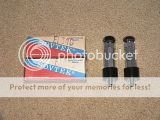
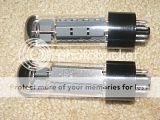
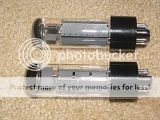
I suppose I shouldn't be surprised to discover they also exhibit glowing grids in my Simple SE. Disappointed perhaps, but not entirely surprised. I quickly shut the amp down, pulled out the tubes, and stuck in a pair of 6CA7EH. I was startled to observe they also had tiny glowing spots on their screens! I had to work a little harder to find them, but they were definitely there. I pulled out the 5AR4 rectifier and stuck in the 5U4GB. Let the supply caps get kicked in balls during startup, who cares! Stuck the Sovtek EL34G back in. Anyhoo, they glow slightly less brightly but the problem is still there.
So, what's going on with my amp? Why are my screens cooking? How do Dynaco Stereo 70 owners survive? I'm considering increasing the screen grid resistors R18 & R28. What's a good value? 1k? Clearly, the lower B+ value resulting from the higher drop of the 5U4 helps a little, but I worry about long term stress to the caps from the startup surge. The blue light show during startup is a little exciting too. First the 5U4 gets a pale blue glow that dances around the inside of the glass for about 1.5 seconds until it's filament gets hot, then the output tubes get a WICKED BRIGHT BLUE GLOW all over the mica and out the plate holes when they're hit with 560 volts. Finally they warm up too, and all the voltages fall back down where they belong and everybody settles down.
Does anyone (who owns a Simple SE, and believes they are safely operating EL34 tubes) want to take responsibility for my Sovteks on loan, and test them out in their amp? Would that person be generous (foolish?) enough to let me test their tubes in my Simple SE? I really need to figure out if I've just had a run of tubes that can't hack it or if there is something else going on in my amp.
Details... outputs are Transcendar 10 watt 5K:8, currently wired for UL operation but I've also tried triode. Power is Hammond 374BX. I used a Hammond choke (159Q) in the power supply instead of the 150 ohm resistor. Line voltage usually tends on the high side here, probably over 125 most days. Simple SE was built out more or less stock. Read the whole story here.
So much for keeping it short...
Resurrecting an old thread... I'll try to keep it brief.
A while ago I tried a pair of Electroharmonix EL34 in my Simple SE. As noted above, I observed glowing grid wires, visible through the plate holes. I wrote off the experiment as a failure. Determined to find some EL34 that work, I bought a set of Sovtek EL34G. After doing a little research I discovered these were not the honeys of the tube world, but they were cheap.



I suppose I shouldn't be surprised to discover they also exhibit glowing grids in my Simple SE. Disappointed perhaps, but not entirely surprised. I quickly shut the amp down, pulled out the tubes, and stuck in a pair of 6CA7EH. I was startled to observe they also had tiny glowing spots on their screens! I had to work a little harder to find them, but they were definitely there. I pulled out the 5AR4 rectifier and stuck in the 5U4GB. Let the supply caps get kicked in balls during startup, who cares! Stuck the Sovtek EL34G back in. Anyhoo, they glow slightly less brightly but the problem is still there.
So, what's going on with my amp? Why are my screens cooking? How do Dynaco Stereo 70 owners survive? I'm considering increasing the screen grid resistors R18 & R28. What's a good value? 1k? Clearly, the lower B+ value resulting from the higher drop of the 5U4 helps a little, but I worry about long term stress to the caps from the startup surge. The blue light show during startup is a little exciting too. First the 5U4 gets a pale blue glow that dances around the inside of the glass for about 1.5 seconds until it's filament gets hot, then the output tubes get a WICKED BRIGHT BLUE GLOW all over the mica and out the plate holes when they're hit with 560 volts. Finally they warm up too, and all the voltages fall back down where they belong and everybody settles down.
Does anyone (who owns a Simple SE, and believes they are safely operating EL34 tubes) want to take responsibility for my Sovteks on loan, and test them out in their amp? Would that person be generous (foolish?) enough to let me test their tubes in my Simple SE? I really need to figure out if I've just had a run of tubes that can't hack it or if there is something else going on in my amp.
Details... outputs are Transcendar 10 watt 5K:8, currently wired for UL operation but I've also tried triode. Power is Hammond 374BX. I used a Hammond choke (159Q) in the power supply instead of the 150 ohm resistor. Line voltage usually tends on the high side here, probably over 125 most days. Simple SE was built out more or less stock. Read the whole story here.
So much for keeping it short...
I have noticed glowing plates on my amp when using Russian 6P3S tubes. I ended up using a switch to select cathode resistors. 820R is permanently in the cct, then there is a switch to place either 1.0K or 2.2K in parallel. This then gives a choice between 820R (6L6), 597R (EL34) or 450R (KT88). For info, I am using the JJ E34L, a higher voltage version of the EL34, so this may make a difference. I think that the photo of the tubes tried by Tubelab on his site show that he was using this same JJ E34L. For what it is worth, I think that the E34L sounds the best in my system, better than the 6P3S, 6P3S-EV, and JJ KT88. See this post switcheable cathode bias Simple SE
I've heard you mention you prefer the sound of EL34, so I'm determined to give them a try.
I'm not having issues exceeding the dissipation limit of the plate. My problem is definitely with the screen grid. At first I thought it only happened to the couple of pairs of EL34 that I tried, but then I saw it happening in my 6CA7EH. The next thing I suppose I need to do is measure the voltage drop across R18/R28 and calculate the screen current. Perhaps that will give me an idea of what is going on.
Funny thing is, the tubes in the photos below perform flawlessly in my Simple SE no matter what, despite their being rated for no more than 250V. The plates will shows signs of over dissipation if you don't keep the cathode resistor sized right, but as you pointed out that's easy to fix - just use the right cathode resistor. Plus, they've got great big inspection holes in the plates. If anything was glowing in there that shouldn't be, I would see it.
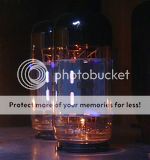
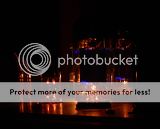
I'm not having issues exceeding the dissipation limit of the plate. My problem is definitely with the screen grid. At first I thought it only happened to the couple of pairs of EL34 that I tried, but then I saw it happening in my 6CA7EH. The next thing I suppose I need to do is measure the voltage drop across R18/R28 and calculate the screen current. Perhaps that will give me an idea of what is going on.
Funny thing is, the tubes in the photos below perform flawlessly in my Simple SE no matter what, despite their being rated for no more than 250V. The plates will shows signs of over dissipation if you don't keep the cathode resistor sized right, but as you pointed out that's easy to fix - just use the right cathode resistor. Plus, they've got great big inspection holes in the plates. If anything was glowing in there that shouldn't be, I would see it.


Hi TY
I am using JJ el34 in my simple SE but I am having strange glow problem:
http://www.diyaudio.com/forums/showthread.php?s=&threadid=135820
(BTW thanks for your reply on this)
the amp is making beautiful music now but if swap the tubes over, one will begin to glow red on the plates while the other will be fine-so I have to leave the tubes in the same channels and not swap them over.
Would you give give JJ el34 a try to see if you still see glowing screen grids?
I am using JJ el34 in my simple SE but I am having strange glow problem:
http://www.diyaudio.com/forums/showthread.php?s=&threadid=135820
(BTW thanks for your reply on this)
the amp is making beautiful music now but if swap the tubes over, one will begin to glow red on the plates while the other will be fine-so I have to leave the tubes in the same channels and not swap them over.
Would you give give JJ el34 a try to see if you still see glowing screen grids?
I'd love to give a set of JJ a try, but I'm not about to buy them if I'm not confident they are going to work well in my amp.
I put back in the 5AR4 and the Sovtek EL34 and took some quick measurements:
459 volts plate
465 volts screen (wired UL)
38.3 volts cathode (810 ohm resistor)
660mV across R18
Math works out to 47.3 mA total current for the tube, of which 6.8 mA is going through the screen. I believe that is 2.9 watts on the screen - isn't the EL34 supposed to be rated for 8 watts Pg2?
If I just ignore it and leave it with little glowing spots on the screen grid, will it eventually settle down and behave? Or will a grid wire melt, fall, and touch an adjacent grid causing a hideous short and a fiery explosion of sparks?
I put back in the 5AR4 and the Sovtek EL34 and took some quick measurements:
459 volts plate
465 volts screen (wired UL)
38.3 volts cathode (810 ohm resistor)
660mV across R18
Math works out to 47.3 mA total current for the tube, of which 6.8 mA is going through the screen. I believe that is 2.9 watts on the screen - isn't the EL34 supposed to be rated for 8 watts Pg2?
If I just ignore it and leave it with little glowing spots on the screen grid, will it eventually settle down and behave? Or will a grid wire melt, fall, and touch an adjacent grid causing a hideous short and a fiery explosion of sparks?
For what it's worth, I took some similar measurements using a beam tube. While the plate voltage and overall tube current is nearly the same, the screen current is about 1/3 of the pentode. This isn't unexpected. I have not yet made any changes to the amp. I have tried searching for information regarding pentodes and methods of triode connecting them. I found a few posts which nearly sum up the way I'm feeling about the whole thing right now:
"...regarding red screens, in my case with EL34s. Not to discourage their use, but after some experience there I went to beam tubes."
"Though they were comparatively sensitive I went off EL34s because I had glowing spots on G2 when I did not want them."
I should still try running it in triode mode again, perhaps with more than 100 ohms between plate and screen. It would be very easy to use a 250 ohm resistor (instead of a jumper wire) between Tx-PRI O2 and O1. In another post, I found some recommended (?) values for the screen resistor:
EL34 Screen Resistors
From experience:
EL34 Triode Mode - use 150R minimum
EL34 Ultralinear - Use 1K minimum
I also found some references to the use of zener diodes to build a voltage dropping network for the screen connection. It seems to be credited to Bill Perkins, and is sometimes called the "Triode Trick". There is an excited thread discussion here, where some members involved feel it is nothing more than a "stinking pile of audiophoolery." I'm still intrigued by the concept, and tempted to try it for myself. I have to wonder why two series connected 470uF/16v caps were used, instead of just a single 35 volt rated part. I also haven't quite figured out the backwards (?) 1N914 diode at the top of the network.
Here's a link to an article describing how to build the zener diode, triode trick:
http://www.t-linespeakers.org/tubes/triode-trick.html
"...regarding red screens, in my case with EL34s. Not to discourage their use, but after some experience there I went to beam tubes."
"Though they were comparatively sensitive I went off EL34s because I had glowing spots on G2 when I did not want them."
I should still try running it in triode mode again, perhaps with more than 100 ohms between plate and screen. It would be very easy to use a 250 ohm resistor (instead of a jumper wire) between Tx-PRI O2 and O1. In another post, I found some recommended (?) values for the screen resistor:
EL34 Screen Resistors
From experience:
EL34 Triode Mode - use 150R minimum
EL34 Ultralinear - Use 1K minimum
I also found some references to the use of zener diodes to build a voltage dropping network for the screen connection. It seems to be credited to Bill Perkins, and is sometimes called the "Triode Trick". There is an excited thread discussion here, where some members involved feel it is nothing more than a "stinking pile of audiophoolery." I'm still intrigued by the concept, and tempted to try it for myself. I have to wonder why two series connected 470uF/16v caps were used, instead of just a single 35 volt rated part. I also haven't quite figured out the backwards (?) 1N914 diode at the top of the network.
Here's a link to an article describing how to build the zener diode, triode trick:
http://www.t-linespeakers.org/tubes/triode-trick.html
In my Simple SE with EL34, triode wired, I use 620 ohm cathode resistors. I don't recall what my screen resistor is, probably whatever was specified in the parts list.
I have found that of my stash:
Mullard (genuine, not Russian)
Tesla
Siemens
General Electric (both Matsushita and Mullard made)
JJ (E34L)
SED
Groove Tubes (Shuguang EL34B)
will make their rated dissipation without plate glow or screen spots at voltages in the mid to mid upper 400's.
Shuguang EL34A will glow at less than 25 watts and mine show hot spots on the screen. Despite that, I have not killed them yet, although I have not tried real hard.
I have not tried many of the beam variants. I lit off an Ei 6CA7 HARD up around 550 volts taking a power transformer with it and that kind of soured me on 6CA7's. The Ei seem to work fine and sound good in the mid 400's though. The Groove Tubes 6CA7GE is another tube of dubious merit. Some work fine. Some don't work at all. The ratio in my small sample has been about 50:50.
I may be off kilter, but minor plate glow never really excites me very much as long as the tube does not take off. Cathode current is what I get concerned about - there are only so many electrons in the cathode. All the plate does is collect them. I tend to go high voltage, lower current, and not worry much about the plate dissipation if the cathode current is reasonable. I keep an ammeter in both my Simple SE and Tubelab SE to constantly meter current.
For big beam tubes, I would just use 6550 and be done with it.
Win W5JAG
I have found that of my stash:
Mullard (genuine, not Russian)
Tesla
Siemens
General Electric (both Matsushita and Mullard made)
JJ (E34L)
SED
Groove Tubes (Shuguang EL34B)
will make their rated dissipation without plate glow or screen spots at voltages in the mid to mid upper 400's.
Shuguang EL34A will glow at less than 25 watts and mine show hot spots on the screen. Despite that, I have not killed them yet, although I have not tried real hard.
I have not tried many of the beam variants. I lit off an Ei 6CA7 HARD up around 550 volts taking a power transformer with it and that kind of soured me on 6CA7's. The Ei seem to work fine and sound good in the mid 400's though. The Groove Tubes 6CA7GE is another tube of dubious merit. Some work fine. Some don't work at all. The ratio in my small sample has been about 50:50.
I may be off kilter, but minor plate glow never really excites me very much as long as the tube does not take off. Cathode current is what I get concerned about - there are only so many electrons in the cathode. All the plate does is collect them. I tend to go high voltage, lower current, and not worry much about the plate dissipation if the cathode current is reasonable. I keep an ammeter in both my Simple SE and Tubelab SE to constantly meter current.
For big beam tubes, I would just use 6550 and be done with it.
Win W5JAG
Ty_Bower said:...Bill Perkins, and is sometimes called the "Triode Trick"... I'm still intrigued by the concept, and tempted to try it for myself.http://www.t-linespeakers.org/tubes/triode-trick.html
I went to Mouser to price out the suggested 1N821 diode. Uh, no. I don't think I'm going to spring for ten of these things at $4.94 each.
The "triode trick" really doesn't make a pentode into a triode, or do any of the magic tricks that it is often associated with.
It can however be used to lower the screen grid dissipation when a pentode is triode wired or UL wired for that matter. The "magic voltage" or the right nimber of the "correct zener diodes" varies with the choice of output tube. Do you need to spend serious money on a collection of 6.2 volt zener diodes? I doubt it. It is true that the temperature coefficient of a zener diode is the lowest when the zener diode is 5.6 or 6.2 volts. Does it make a difference in this case? No. Do you need two OSCONS in series, well maybe if you believe that OSCONS are magical. Do you need the 1N914? Well that is another magic tale. I don't really subscribe to this one, but if you want to use a diode here, make it a 1N4001 type. The screen can draw enough current to blow a 1N914.
I have used this "trick" especially when abusing sweep tubes. I have used whatever zener diode or combination of zener diodes that I could find in my junk box. Noise isn't an issue since the diodes are bypassed by a capacitor. I use a decent quality (Panasonic) enectrolytic in parallel with a .1 uF polypropelyne. I have used a single 33 volt 5 watt zener diode on a Simple SE to "cool off" some glowing tubes when running B+ over 500 volts.
The larger the voltage of the zener (or multiple zeners) the lower the screen dissipation. Too large of a zener voltage will cause distortion on large signals. The screen voltage dips too low causing tube nonlinearity. I have even used gas regulator tubes like the 0A2 when running sweep tubes. Not really a good idea.
A faint red glow is not usually a bad thing on an older tube. Some of the newer stuff isn't made of pure materials nor is the vacuum as hard. A glowing plate can cause outgassing of some of these imputities, which will cause an increase of grid gurrent, and you guessed it tube runaway.
Yes, it is. I have a pair of "Winged C" tubes that have screens that glow brightly when the voltage is anywhere above 320 volts. All of the modern tube manufacturers simply copy the old Mullard specs, but they don't copy the old Mullard quality control. Some tubes are far worse than others, but all of the electrodes need to be aligned correctly for proper dissipation.
It can however be used to lower the screen grid dissipation when a pentode is triode wired or UL wired for that matter. The "magic voltage" or the right nimber of the "correct zener diodes" varies with the choice of output tube. Do you need to spend serious money on a collection of 6.2 volt zener diodes? I doubt it. It is true that the temperature coefficient of a zener diode is the lowest when the zener diode is 5.6 or 6.2 volts. Does it make a difference in this case? No. Do you need two OSCONS in series, well maybe if you believe that OSCONS are magical. Do you need the 1N914? Well that is another magic tale. I don't really subscribe to this one, but if you want to use a diode here, make it a 1N4001 type. The screen can draw enough current to blow a 1N914.
I have used this "trick" especially when abusing sweep tubes. I have used whatever zener diode or combination of zener diodes that I could find in my junk box. Noise isn't an issue since the diodes are bypassed by a capacitor. I use a decent quality (Panasonic) enectrolytic in parallel with a .1 uF polypropelyne. I have used a single 33 volt 5 watt zener diode on a Simple SE to "cool off" some glowing tubes when running B+ over 500 volts.
The larger the voltage of the zener (or multiple zeners) the lower the screen dissipation. Too large of a zener voltage will cause distortion on large signals. The screen voltage dips too low causing tube nonlinearity. I have even used gas regulator tubes like the 0A2 when running sweep tubes. Not really a good idea.
I may be off kilter, but minor plate glow never really excites me very much as long as the tube does not take off.
A faint red glow is not usually a bad thing on an older tube. Some of the newer stuff isn't made of pure materials nor is the vacuum as hard. A glowing plate can cause outgassing of some of these imputities, which will cause an increase of grid gurrent, and you guessed it tube runaway.
Math works out to 47.3 mA total current for the tube, of which 6.8 mA is going through the screen. I believe that is 2.9 watts on the screen - isn't the EL34 supposed to be rated for 8 watts Pg2?
Yes, it is. I have a pair of "Winged C" tubes that have screens that glow brightly when the voltage is anywhere above 320 volts. All of the modern tube manufacturers simply copy the old Mullard specs, but they don't copy the old Mullard quality control. Some tubes are far worse than others, but all of the electrodes need to be aligned correctly for proper dissipation.
I haven't bought my zeners yet. I did wire it up for triode again (easier on the screens?) and added an extra 250 ohms to the 100 that's already on the board. I also plugged in the 5U4 instead of the 5AR4 to drop a few extra volts.
The darn screens still glow on the Sovtek EL34. I can tell things are headed in the right direction - spots which were yellow and orange and now orange and red. Still, there shouldn't be any spots on the screens at all, should there? I wonder how low I need to get the screen voltage before it behaves?
What's the failure mode if I just leave it running this way? Is it going to take out the cathode caps & resistors when it fries? Am I risking the output transformers? If the tubes poof, no big loss. I'd prefer not to damage the amp...
The darn screens still glow on the Sovtek EL34. I can tell things are headed in the right direction - spots which were yellow and orange and now orange and red. Still, there shouldn't be any spots on the screens at all, should there? I wonder how low I need to get the screen voltage before it behaves?
What's the failure mode if I just leave it running this way? Is it going to take out the cathode caps & resistors when it fries? Am I risking the output transformers? If the tubes poof, no big loss. I'd prefer not to damage the amp...
Still, there shouldn't be any spots on the screens at all, should there?
The screen grids should not glow. As you have found this is just about impossible on some EL34's.
added an extra 250 ohms to the 100 that's already on the board
Some users have gone as high as 1K ohms. In fact some people claim that 1K in series with the screen is a "magic value" that reduces distortion in UL mode on the EL34. The Mullard data sheet does specify 1K ohms in UL mode and up to 1.5K in pentode mode. If you are using EL34's you can try a 1K resistor, even in triode mode. I specify a 100 ohm resistor in the parts list as a compromize since larger values tend to cause distortion with some KT88's.
I tried resistors as high as 2.2K with the glowing pair of Winged C EL34's that I have, and they still glow. 2.2K caused some ugly distortion on heavy bass. The resistor started smoking too. I have just given up on that set of tubes.
What's the failure mode if I just leave it running this way?
I suppose anything is possible. The glowing wires will cause contamination of the vacuum leading to a short lifetime of the tubes. Likely the distortion will increase over time. The tube current could increase due to grid current, and eventual tube runaway is possible. If the amp has a fuse in the line cord (2 amp on 120 volts) the fuse will usually blow before anything else is damaged. It is possible that a tube arc could occur. There was a thread on this forum several months back where a users amp was damaged by a defective KT88 causing the cathode resistor and cap to fail. I don't remember if that amp was properly fused or not. Damage to the OPT is highly unlikely.
I have managed to blow the screen grid resistor twice (EL34's both times) in early the early development stages of the Simple SE. That was when I was using 1/2 watt resistors. There have been no failures with 1 or 2 watt resistors. I also managed to blow a cathode resistor and capacitor rather violently when I intentionally put some known gassy 6V6's into my Simple SE that was running at plate voltages far too high for 6V6's.
http://www.diyaudio.com/forums/showthread.php?s=&threadid=124527&highlight=
In case anyone was wondering, I have found a set of EL34 that appears to work just fine in my Simple SE. This seems to prove (to me, at least) that the glowing screen problem was with the junky tubes I tried, and not with my Simple SE amp. I received a loaner pair of JJ E34L tubes and tried them out tonight.
The holes in the plates are rather small, and it makes for difficult inspection of the screens. The red lettering that JJ uses for their logo further complicates matters - I keep catching glimpses of that logo out of the corner of my eye, and I need to look twice to see if the red color is coming from something inside the tube. In any event, I haven't been able to see any indications of the glowing screens that were prevalent in EH and Sovtek tubes I tried.
I will make a brief comment with regards to all the "quality control" comments I've read about JJ. The pins on these tubes do not have the nice rounded ends I see on nearly all my other tubes. One tube of the pair has rather square ends on the pins, and the other has conical sections at the ends. I doubt this causes much trouble, especially if one is cautious when inserting the tube. They do also feel slightly looser in the socket than my EH tubes. On the other hand, I've always felt my EH tubes were too tight in the sockets, and almost required unnecessary force to seat them fully.
The only other comment I can make at this time with regards to the construction quality of these JJ tubes is that the coloring of the tube is kinda odd. These are the "blue" JJ tubes, but it sure doesn't seem like blue glass to me. It appears more like one of those Swirl-an-Egg things you did as a child, with a sorty stripey blue smear down the side of the envelope. I'm guessing it's clear glass, and the blue is somehow applied after the fact. Purely a cosmetic thing, but still not what I would have expected.
It's too early for me to comment on their sonic qualities. Absolutely nothing offensive so far; indeed they sound very good. They seem to have a very natural (and neutral) quality to the sound. Thinking about it while listening to them makes me suspect that EH tubes I've been using previously might have had a touch of "bass in your face" kind of weight to them. Of course, the differences are much more subtle than I make them sound. I haven't heard a truly bad tube sound come out of the Simple SE, regardless of which tubes I've used.
The holes in the plates are rather small, and it makes for difficult inspection of the screens. The red lettering that JJ uses for their logo further complicates matters - I keep catching glimpses of that logo out of the corner of my eye, and I need to look twice to see if the red color is coming from something inside the tube. In any event, I haven't been able to see any indications of the glowing screens that were prevalent in EH and Sovtek tubes I tried.
I will make a brief comment with regards to all the "quality control" comments I've read about JJ. The pins on these tubes do not have the nice rounded ends I see on nearly all my other tubes. One tube of the pair has rather square ends on the pins, and the other has conical sections at the ends. I doubt this causes much trouble, especially if one is cautious when inserting the tube. They do also feel slightly looser in the socket than my EH tubes. On the other hand, I've always felt my EH tubes were too tight in the sockets, and almost required unnecessary force to seat them fully.
The only other comment I can make at this time with regards to the construction quality of these JJ tubes is that the coloring of the tube is kinda odd. These are the "blue" JJ tubes, but it sure doesn't seem like blue glass to me. It appears more like one of those Swirl-an-Egg things you did as a child, with a sorty stripey blue smear down the side of the envelope. I'm guessing it's clear glass, and the blue is somehow applied after the fact. Purely a cosmetic thing, but still not what I would have expected.
It's too early for me to comment on their sonic qualities. Absolutely nothing offensive so far; indeed they sound very good. They seem to have a very natural (and neutral) quality to the sound. Thinking about it while listening to them makes me suspect that EH tubes I've been using previously might have had a touch of "bass in your face" kind of weight to them. Of course, the differences are much more subtle than I make them sound. I haven't heard a truly bad tube sound come out of the Simple SE, regardless of which tubes I've used.
- Status
- This old topic is closed. If you want to reopen this topic, contact a moderator using the "Report Post" button.
- Home
- More Vendors...
- Tubelab
- Simple SE and EL34
